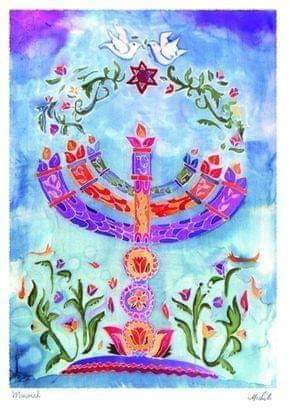Roger Froikin @rlefraim wrote, "SHABBAT SHALOM
Parshat Tetzaveh Exodus 27:20–30:10
I generally do not see much to interpret or to discuss in those Parshiot that just describe a function or clothing or objects. 1)

Roger Froikin @rlefraim wrote, "SHABBAT SHALOM
Parshat Tetzaveh Exodus 27:20–30:10
I generally do not see much to interpret or to discuss in those Parshiot that just describe a function or clothing or objects. 1)

But this Parsha does have interesting statements that for me need to be looked at.
HaShem tells Moses to receive from the children of Israel pure olive oil to feed the “everlasting flame” of the menorah, which Aaron is to kindle each day, “from evening till morning.” 2)
Mystery. How can an “everlasting flame”. Be “everlasting”, if it was only lit from Evening till Morning and had to be relit?
It is assumed by most that what this meant was that the flame had to be tended to make sure it did not go out at night when few people were around,
3)
but in the daytime, there would be several people able to tend it, so that was not needed to be mentioned.
But picture this. A dark night. Tens of thousands of tents surround a central point in a valley.
4)
The light is in the Tabernacle, and in the darkness, it can be seen from a distance from most if not al of the tents. It would have been a comforting, uniting, experience, a thing experienced by the entire people. Impressive. A reminder of unity and identity. 5)
The priestly garments, to be worn by the kohanim (priests) while serving in the Sanctuary, are described. All kohanim wore: 1) the ketonet—a full-length linen tunic; 2) michnasayim—linen breeches; 3) mitznefet or migba’at—a linen turban; 6)
In addition, the kohen gadol (high priest) wore: 5) the food—an apron-like garment made of blue-, purple- and red-dyed wool, linen and gold thread; 7)
Tetzaveh also includes G‑d’s detailed instructions for the seven-day initiation of Aaron and his four sons—Nadav, Avihu, Elazar and Itamar—into the priesthood, 9)
and for the making of the golden altar, on which the ketoret (incense) was burned
It’s a mystery as to the function of thse garments. Just as it has been a mystery as to why it was dangerous to touch the box in which were the Tablets Moshe Rabbeinu brought down from Sinai.
10)
I’m not good just believing mysteries.
This might be interesting, though. In the late 1960’s a professor at a US University, I think it was in Wisconsin or Minnesota, decided to build a smaller version of the arc in which Moshe Rabbeinu carried the Tablets of Law.
11)
He managed over a whole year to build it, finishing by the end of the Spring term, after which this small arc was placed in storage over the summer. Four months later, the professor and a few students went into the storage area to brink out his arc.
12)
One of the students touched it, and a shock thrust him across the room. It seems the box accumulated a very strong electric charge because of the materials and design of the construction, 13)
and could only be moved afterward by two poles inserted in handles built into the frame of the box. Now, remember the stories about how touching the arc was and one could die? 14)
The lesson? Don’t discount the details of this Parsha as seemingly having little meaning. It may just be meaning we do not currently understand." 15)